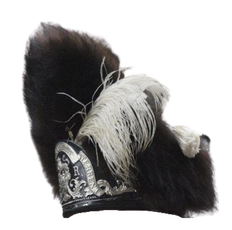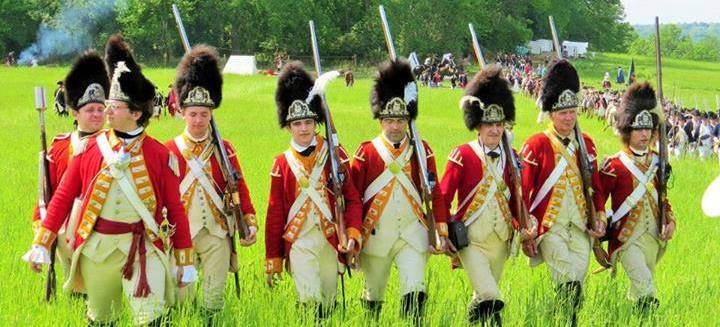35th Regiment of Foot, Grenadier Company
American Revolution 1775-1783
In 1775, grievances became open rebellion in the American colonies against Great Britain over matters of taxation, trade, and autonomous governance. After the battles of Lexington and Concord in April, more British troops arrived in Massachusetts with the mission of ending the rebellion once and for all. The 35th Regiment of Foot departed Cork, Ireland, and arrived in Boston in June, with the grenadiers and light infantry participating in the Battle of Bunker Hill nearly as soon as they were off the ships. The regiment would continue to serve in the New York/New Jersey campaign, Philadelphia Campaign, and later be sent to the Caribbean when France and Spain entered the war. It would be ten years before the 35th would return home to Ireland. While the war was lost for Britain, the regiment never knew defeat on the battlefield.
Who are the Grenadiers?

Most British infantry regiments were single-battalion entities made up of ten companies, two of which were "flank companies" posted to the left and right of the line. At the start of the war, companies were nominally 38 rank and file, plus NCOs and officers. The flank companies were the grenadiers and the light infantry. The grenadiers were made up of the tallest and steadiest men of the regiment. In the American Revolution, the flank companies of the various regiments were often detached to form battalions of grenadiers and lights in their own right. These were used as shock troops, skirmishers, and reconnaissance. The grenadiers were distinguished with the tall bearskin caps, shoulder wings on their uniforms, match cases on their belts, and continuing to wear swords after they had fallen out of use with the army as a whole. Over time, many of these features were put aside for more practical dress in the rigors of American campaigning.
We have chosen to represent the grenadier company because this company saw the most action in the 35th's experience. The versatility of the grenadiers, plus their unique appearance and role, makes them an ideal subject for interpreting the British soldier of the time and demonstrating that the army was not a body of robotic, mindless automatons, but rather an adaptive, flexible force under competent leadership dealing with extraordinarily challenging circumstances and opposition, logistically, militarily, and politically.
We have chosen to represent the grenadier company because this company saw the most action in the 35th's experience. The versatility of the grenadiers, plus their unique appearance and role, makes them an ideal subject for interpreting the British soldier of the time and demonstrating that the army was not a body of robotic, mindless automatons, but rather an adaptive, flexible force under competent leadership dealing with extraordinarily challenging circumstances and opposition, logistically, militarily, and politically.
Recreated 35th Regiment Today
The Royal Sussex Society recreates the 35th Regiment of Foot and participates in events around the Mid-Atlantic area to educate and interpret the life and times of the American Revolution. Since 2010, the 35th Regiment has been a proud member of the British Brigade, a 501(c)3 organization which serves as a reenactment umbrella group, fostering and promoting battle events in the eastern United States. Whether fielding the soldiers of King George III to demonstrate 18th C. tactics and encampments, or the day-to-day lives of the men and women who followed and supported, the armies on campaign, we strive to do so authentically and share our passion for history with others.
Officers and Gentlemen

The British officer corps was a world unto itself within the British army. Officers were typically gentlemen who had means and usually some education, whereas the rank and file usually came from the lower strata of society: underemployed agricultural hands, skilled and unskilled laborers chief among them. Infantry officers purchased their expensive commissions, rather than graduating a military academy or, very rarely, by rising up through the ranks. Typically, a young gentleman would purchase his commission as an ensign, the lowest commissioned officer rank, for the princely sum of £400, and begin his career. Companies were generally led by a captain, a lieutenant or captain-lieutenant, and an ensign. Those ranked major and above were 'field officers' with broader responsibilities.
The 35th Regiment's Grenadier Company had four known captains during its service in the American Revolution.
Capt. James Lyon, start of war - June 29, 1775 (dead of wounds, Bunker Hill);
Capt. Charles Stuart, June 30 - Oct 7, 1775;
Capt. Erasmus John Phillips, Oct. 8, 1775 - January 2, 1777 (murdered);
Capt. Hugh Massey, March 6, 1777 - end of war
The 35th Regiment's Grenadier Company had four known captains during its service in the American Revolution.
Capt. James Lyon, start of war - June 29, 1775 (dead of wounds, Bunker Hill);
Capt. Charles Stuart, June 30 - Oct 7, 1775;
Capt. Erasmus John Phillips, Oct. 8, 1775 - January 2, 1777 (murdered);
Capt. Hugh Massey, March 6, 1777 - end of war
35th Regiment of Foot - Stationed in America 1778/1779
This information is provided only as a reference and a tribute to the officers of the 35th Regiment of Foot.
The Royal Sussex Society cannot assist with genealogical services.
The Royal Sussex Society cannot assist with genealogical services.
|
Colonel
General Henry Fletcher Campbell Lt. Colonel James Cockburne Major George Berclay Captains Hunt Fitz Gerald Edward Drew (Light Co.) Colin Campbell Colin Campbell Archibald M'Alister Hugh Massey (Grenadier) Thomas Bomford The Hon. Lockhart Gordon Cornelius Smelt Captain-Lieutenant & Captain Alexander Robertson Chaplain Hopkins Fox Surgeon Alexander Ore |
Lieutenants
Thomas Williams Arthur Ross James Lamb, Adjutant William Clarke Charles Menzies Paliser Wheeler Robert Gordon Thomas Murray David Campbell Charles Stevenson John Graham Daniel Shaw Bryan Blundell Ensigns William Pilkington Samuel Fitzgerald, Quarter-Master Hugh Campbell Robert Campbell John Bevan John Armstrong Gilbert Waugh Charles Bingham Joseph French Terence M'Dermot |

